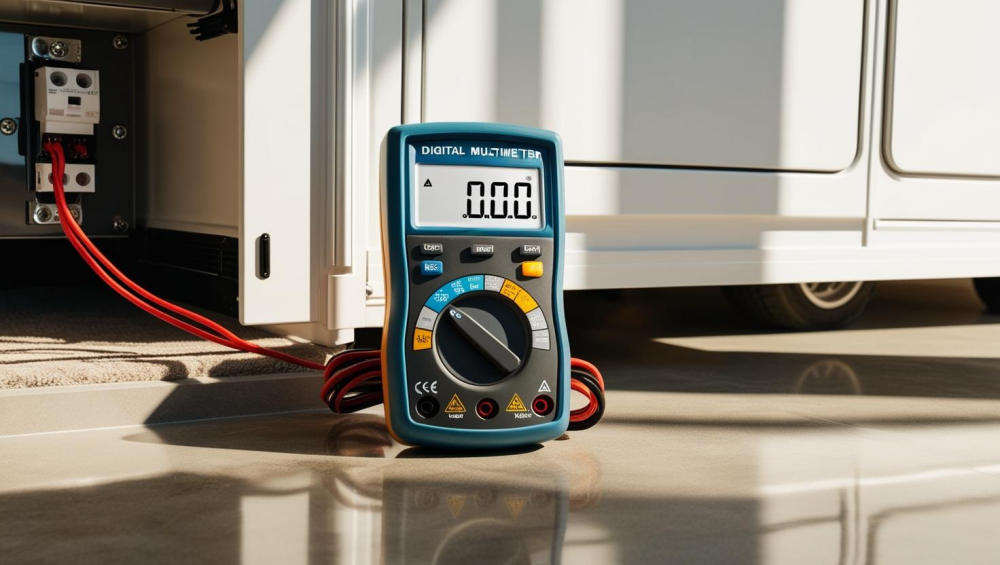Electrical problems on the road can quickly turn a great RV adventure into a stressful situation. Whether it’s a dead outlet, flickering lights, or a total power failure, knowing how to troubleshoot RV electrical problems is essential for a safe and stress-free trip. Here’s how to recognize common issues, diagnose them properly, and keep your RV’s electrical system running smoothly.
Understanding Your RV’s Electrical System
⚡ Common RV Electrical Problems
Before diving into any electrical fixes, it’s vital to understand the most common problems RV owners face:
- Overloaded Circuits: Plugging too many appliances into one outlet or circuit can trip breakers or blow fuses.
- Faulty Wiring: Damaged or outdated wiring increases the risk of shorts, fires, and other dangerous malfunctions.
- Battery Problems: Dead or dying batteries often cause 12V systems to fail.
- Tripped Breakers and Blown Fuses: Pay attention to this one. These are usually warning signs of deeper electrical issues.
🚨 Safety First:
Before troubleshooting RV electrical problems, always turn off the power supply or unplug from shore power to avoid electric shocks. This is the electricians first rule.
Routine inspections can catch worn wires, corrosion, and battery issues before they strand you. But when in doubt, don’t hesitate to consult a professional electrician for major wiring problems.
RV Electrical Systems- What do you NEED to know?
🛠️ Troubleshooting RV Electrical Problems

Here is a step-by-step troubleshooting guide to refer to if your RV suddenly loses power or an appliance won’t work.
- Check the Power Source:
Make sure your shore power connection, generator, or battery system is functioning. A common oversight is an empty generator fuel tank or a tripped campground breaker. - Use a Multimeter:
A multimeter is a must-have tool. It allows you to test voltage, continuity, and determine whether your outlets, batteries, and converters are supplying the correct current. - Inspect Circuit Breakers, Converters, and Fuses:
Locate your breaker panel (check your manual if necessary, Keystone RV converters are often located inside the breaker box). Reset any tripped breakers or replace blown fuses. - Understand the Root Cause:
A tripped breaker or blown fuse usually signals an underlying problem—like an overloaded appliance or faulty wiring. Finding and addressing the root cause prevents repeat issues. - Test Appliances and Outlets:
If certain appliances aren’t working, simply plug them into a different outlet. Use an outlet that you know is working. If the appliance works elsewhere, your outlet may be faulty. - Inspect Wiring:
Visually check for damaged or frayed wires, especially in areas exposed to movement (like slide-outs) or moisture. - Check the GFCI:
Your RV’s Ground Fault Circuit Interrupter (GFCI) outlets protect you from shocks. If they’re tripped, reset them—imbalances in current can trigger them during wet or humid conditions.
🔋 Practical Solutions to Keep Your RV Powered
Here are a few ways to prevent and fix common electrical issues.
- Manage Appliance Use:
To help prevent overloaded circuits, try to spread out your appliance usage. Always avoid running heavy power users (like a microwave and AC) simultaneously on the same line. - Maintain Healthy Batteries:
Regularly check water levels (for lead-acid batteries), clean terminals, and test charge levels. Auto parts stores will often test 12 Volt batteries for free. Replace old or unreliable batteries before a big trip. - Reset Breakers and Replace Fuses Properly:
Always use correctly rated fuses. Most electrical panels have a legend listing proper size for each breaker and fuse. Repeated tripping indicates a deeper issue that needs attention. - Monitor Your Converter:
Your converter switches shore power (120V) into usable RV power (12V). If lights dim or appliances fail, the converter could be malfunctioning and may need repair or replacement.
🧰 Essential Maintenance Strategies and Tools
Prevention is key when it comes to RV electrical problems. Here’s how to stay ahead:
- Regular Electrical System Inspections:
Add electrical checks to your regular maintenance routine. Inspect the battery terminals and test all of the outlets. Monitor the converter’s operation and make sure the shore power cables are in good condition. - Maintain Your Generator:
Change the oil, replace air filters, and run your generator monthly—even when not camping—to keep it reliable. - Carry Vital Tools and Spare Parts:
Essential gear includes:- A reliable multimeter
- Assorted spare fuses
- Replacement breakers
- Electrical tape
- Spare shore power adapters (30-amp and 50-amp)
- Use a Maintenance Checklist:
Create a simple checklist for monthly inspections. Include tasks like battery voltage tests, breaker inspections, and GFCI outlet checks.
❓ Frequently Asked Questions
There are several reasons your RV might not get power even when plugged in. Check the shore power connection, verify the breaker at the power pedestal, and inspect your RV’s main breaker panel for tripped breakers or blown fuses. Verify shore power cable.
Locate your RV’s breaker panel, find the tripped breaker (it’ll often be slightly out of position), and firmly switch it off and then back on. If the breaker trips again immediately, there is an underlying electrical problem that needs troubleshooting.
A basic electrical toolkit should include a multimeter, spare fuses, a few replacement breakers, electrical tape, and spare shore power adapters. Having these tools on hand can save you a lot of trouble on the road.
If you experience repeated breaker trips, notice burning smells, see exposed wiring, or feel uncomfortable handling the problem yourself, it’s best to call a certified RV electrician to avoid further damage or risk.
💭 Final Thoughts
Troubleshooting RV electrical problems doesn’t have to be intimidating. There are many reliable and cheap multi-meters on the market. They are invaluable when electrical problems arise. With the right tools and a little knowledge, you can handle most minor issues yourself. Regular maintenance helps keep your adventures rolling smoothly. Always prioritize safety first. When the situation goes beyond your comfort zone, call in a professional. Get yourself and your RV back on the road safely.





This is such a valuable guide, especially for anyone who spends a lot of time on the road in their RV! Electrical issues can feel overwhelming if you’re not prepared, but you laid out the troubleshooting steps so clearly and made it much less intimidating. I especially appreciate the emphasis on safety and using a multimeter — it really is an essential tool. Having traveled extensively in rural areas with my camper, I’ve learned how crucial a reliable power system is for both comfort and communication. Your practical tips on preventing problems before they start are spot-on. Regular inspections and a well-stocked toolkit truly make all the difference when you’re miles from the nearest help!